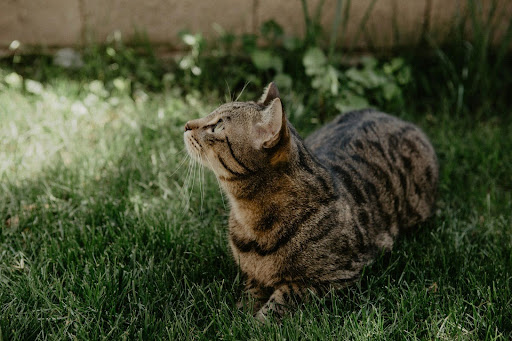Okay, I probably know what goes through your mind — letting a cat outside means either they will lose or get involved in cat-turf fighting. Yes you are right on your part. But never notice your feline friend in, wishing to join you when you’re watering your beautiful plant and enjoying sunbathing? Trust me, allowing your pet outside is much more beneficial than having drawbacks.
Not only will your cat get a healthy dose of sunlight and fresh air, but you can also create a stimulating environment that fulfills their natural instincts. Think bird watching (from a safe distance, of course!), exploring exciting textures and indulging in a luxurious sunbathing session.
Instead of endlessly fighting to keep your cat away from your precious flowers, why don’t you create a cat paradise right inside your green haven? It’s not just about converting your garden into a cat playground (though, who wouldn’t love that?)
Think of it as a strategic move. By creating a cat-friendly zone, you can distract those curious paws from exploring other, perhaps less desirable areas of your yard. If you’re ready to put your green thumb — or paw — to work, keep reading for purr-fect tips on creating a cat-friendly haven your furry friend will adore.
Why Is an Enriching Outdoor Space Crucial for Cats
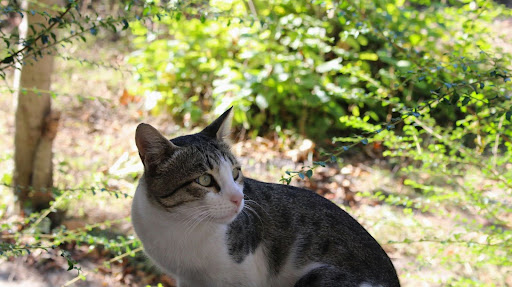
Many cats treasure their outdoor space just as much as their indoor domain.
Offering them a fulfilling outdoor environment that feels safe and secure is key to their happiness. Not only does it improve their well-being, but it also keeps them from wandering too far from home, lowering their risk of encountering dangers like busy roads.
However, there are few for benefits-
- It’s a jungle out there (in a good way!): Outdoor spaces stimulate all their senses, from new smells to the feel of grass under their paws. This sensory stimulation keeps cats mentally stimulated and relaxed, ready for a cozy catnap when they return home.
- Born to climb and pounce: Cats are born climbers and hunters. A cat-friendly outdoor enclosure with climbing structures and hiding spots allows them to unleash their inner explorer, burning off energy and reducing boredom when they’re back inside.
- Peace in the purr-adise: Enriching outdoor spaces provide mental stimulation and exercise, reducing stress and preventing demanding behaviors in indoor cats. Your feline friend may become more independent and content with their outdoor adventures.
- Sharing is caring (especially with more space): Cats in multi-cat households can sometimes get territorial. Outdoor spaces offer more resources like climbing spots and sunny patches, reducing territorial conflicts in multi-cat households. With plenty of room to explore and relax, cats can peacefully share their outdoor jungle gym.
- Sunshine kitty! Sunlight is essential for your cat’s bone health and overall well-being. Spending time outdoors allows them to soak up safe sunshine, keeping them active, fit, and healthy (especially good for cats that are generally inactive or overweight).
9 Ways to Make Cat-Friendly Garden or Outdoor Space
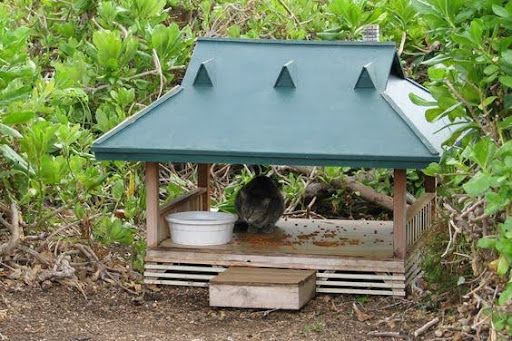
Does your feline friend spend hours gazing longingly out the window? Unleash their inner explorer and create a captivating outdoor haven they can call their own! These tips will help you to know How to Create a Cat-Friendly Garden or Outdoor Space:
Shelter and Hiding Places
Not all cats mind a little rain! Some love exploring even when it’s wet. To keep them comfy, create a cozy shelter. An old box turned into a secret den or a special cat house will be their happy place to watch the world (or take a nap) during a sprinkle.
To create hidden spaces, consider simple structures like open-ended teepees made of boards or garden umbrellas laid on their side. Planting heathers and lavenders can also form natural hideaways as they turn into a cozy “forest” for your cat.
Near the entrance to your outdoor space (such as a cat flap), create a safe hiding spot. Cats appreciate having a quick escape route if they sense danger. An overly open garden can leave them feeling exposed, so dense shrubs, patchy foliage, and old wooden boxes provide ideal hiding places.
For a touch of adventure, place tables and chairs in your outdoor area. Cats love to perch on these elevated spots, surveying their domain from a safe distance.
Playtime – Toys that Tempt
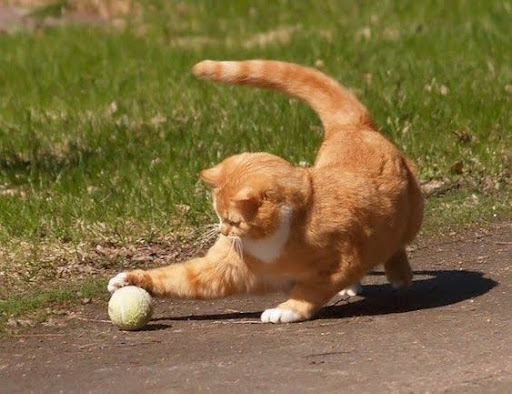
Just like humans, cats need exercise for their bodies and minds. Outdoor toys keep them entertained and prevent boredom that can lead to bad habits like scratching furniture. Think about things that satisfy their natural hunting instincts – anything that can be chased, swatted, or pounced on is a win!
Hang string toys from low branches or fences, letting the wind turn them into enticing prey. Balls, feather wands, and even cardboard boxes become exciting playthings in your cat’s outdoor kingdom.
Climbing Opportunities
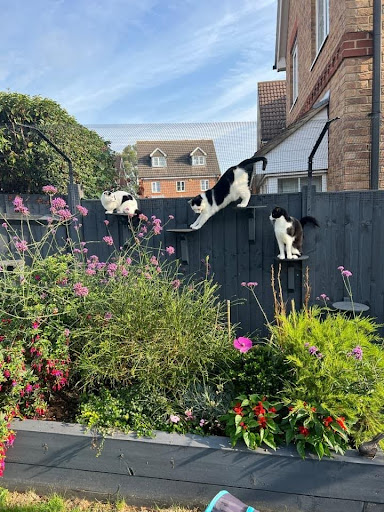
Remember Simba surveying his pride from the top of Pride Rock? Cats love a good vantage point. Provide climbing opportunities like different sized logs or a frame built with fence panels. This lets them survey their domain, bask in the sun, and add a touch of vertical adventure to their outdoor world.
Pathways and Scratching Posts
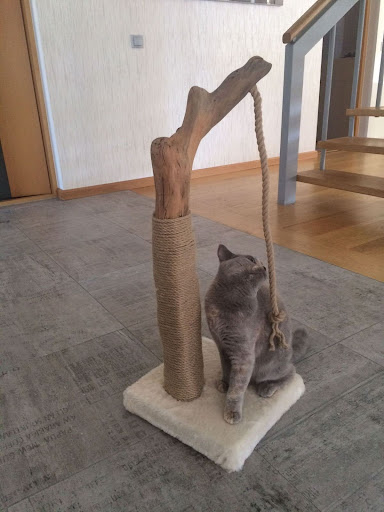
Scratching is a natural instinct for cats, used to sharpen claws, mark territory, and stretch. Unless your cat is declawed (and in that case, outdoor adventures might not be safe), providing designated scratching spots is key!
To keep your garden and furniture claw-mark free, dot your landscape with scratching posts made from materials like sisal rope (cats love the texture!). Pieces of cardboard or sturdy logs can also be offered.
Get creative! Tie wood or logs together with sisal rope – the rope itself becomes an enticing scratching surface for your feline friend.
For wriggling walkways, create winding pathways throughout your garden using stepping stones, pavers, or even strategically placed potted plants. This lets your cat explore, stalk imaginary prey, and satisfy their natural hunting instincts.
Fencing and Enclosures
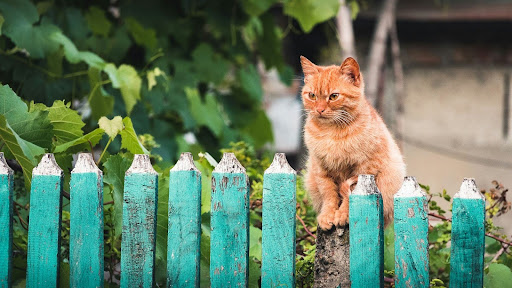
An enclosed space is vital to keep your furry friend safe from predators and prevent them from wandering off.
Surround your garden with sturdy, cat-proof fencing. Consider adding screen fencing on top of existing fences for extra security. Roller bars at the top can help keep adventurous felines from scaling their way out, while also deterring other animals from entering.
Build a DIY “catio” – a screened enclosure that allows your cat to enjoy the outdoors safely. Alternatively, purchase a pre-made enclosure or even consider screening in your porch or patio, creating a shared outdoor space for you and your feline companion.
Toileting Area
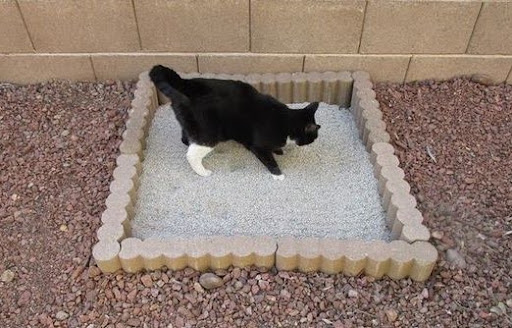
Cats who explore both indoors and outdoors might use their indoor litter box without a problem. However, accidents can happen!
If you don’t wanna use a traditional litter box, then carve out a recessed space in your garden where the box sits discreetly. Alternatively, create a “cat loo” by concealing the box inside a large decorative container that complements your garden design.
Regular litter box filler works, but wood chips or sand can be more natural-looking alternatives. One thing is important to mind – privacy is key for cats, so consider placing the hidden box under a bush or in a secluded area.
Want to discourage bathroom breaks in specific areas? Lay down a layer of wire mesh under the dirt, sand, mulch, or compost. This unexpected sensation will gently nudge your cat towards the designated restroom area you’ve created.
Comfortable Resting Spots
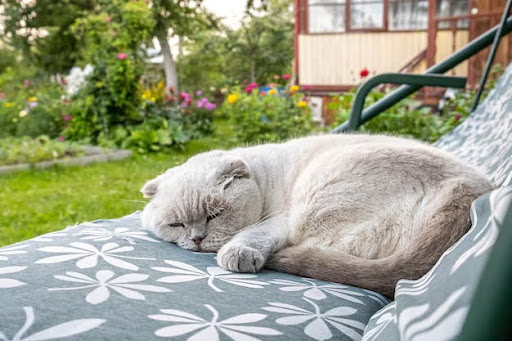
Your cat needs comfy spots to relax and soak up the sun. Leaving out an old cushion or providing a sheltered ‘cat house’ with blankets offers cozy spots for your feline friend to relax and sleep.
To ensure the garden remains exclusive to your cats, consider adding a strip of plastic mesh atop the fencing. This acts as a deterrent for neighborhood cats, maintaining the privacy and tranquility of the space for your own cats.
Cat-Friendly Plants
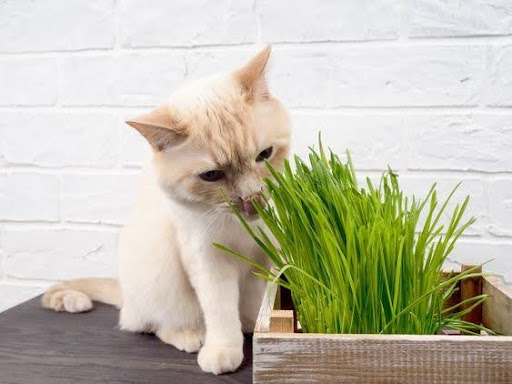
Transform your space into a lush haven with cat-friendly plants! Choose vibrant options that are safe for your feline friend to explore and sniff.
Plants that attract butterflies and flying insects (like native species with purple flowers) not only benefit wildlife but also provide entertainment for your cat! They can stalk these fluttering friends, adding a touch of playful excitement to their outdoor adventures.
Here are some fantastic feline-friendly flora options:
- Cat Grass: This specially designed grass caters to your cat’s natural instinct to munch on greenery, aiding digestion.
- Catmint & Mint Family: These aromatic plants may entice your cat with their fascinating scents and textures.
- Catnip: The “happy herb” for cats! Around 50-70% of felines find the chemicals in catnip leaves stimulating or even hallucinogenic, leading to playful antics.
- Honeysuckle & Valerian: Similar to catnip, these plants can have stimulating or calming effects on some cats (around 30% for honeysuckle). Experiment and see if your feline friend enjoys their unique properties.
- Maiden Grass (Miscanthus): Offer the perfect environment for your kitty to prowl around. The tall blades provide excellent cover, and while the roots are not suitable for munching, all other parts of the plant are safe for your curious cat.
- Sunflowers: These cheery giants are easy to grow and offer plenty of hiding space for your cat. The blooms add an extra touch of fun, especially when placed near climbing structures.
- Asters: Low-maintenance and perfect for dense cover, these flowering plants create ideal stalking grounds for your cat’s hunting expeditions.
- Cosmos: These wispy plants provide beautiful color and excellent screening, perfect for a cat who appreciates a bit of privacy.
- Blue Mist Shrub (Caryopteris): This attractive shrub is a haven for pollinators and provides ample privacy and shelter for your cat, allowing them to observe their domain in peace.
There are some veggies that are safe for your cat, such as cucumbers, squash, pumpkins. Their vining forms create hiding spaces and climbing opportunities. Runner Beans is another hiding haven option, providing cool shade for your cat on hot days.
Fresh Water Source
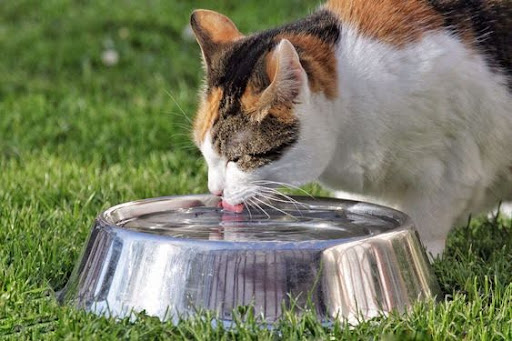
Cats are naturally drawn to moving water, so consider a bubbling fountain or a small pond. For ponds with fishy residents, a net just under the surface keeps your cat safe and the fish stress-free.
So, you’ve got small spaces? Don’t worry. A circulating water bowl provides a continuous flow, discouraging pesky mosquitoes while giving your cat easy access to cool, refreshing water. Look for pet fountain options specifically designed for outdoor use at most pet stores.
Some felines prefer a more “natural” source than tap water. Collect rainwater in a container from a water butt (a barrel that collects rainwater runoff) if you have one. Alternatively, leave out a large dish during rainy days.
Providing several water sources in different locations helps reduce competition, especially if your feline friend shares their outdoor haven with other cats.
Some Safety Measurement You Should Consider
Ensuring the safety of your feline friend outdoors involves several important measures:
Avoid Harmful Chemicals
Keep your garden free from toxic substances. Avoid using pesticides, herbicides, or fertilizers that could harm your cat. Opt for pet-safe alternatives whenever possible.
Keep Away Poisonous Plants
Remember, Not All Plants are Purrfect: While some plants provide playful fun, others are toxic or irritating to cats. There are some plants to avoid in your cat-friendly garden, such as:-
- Alstroemeria, Lily (all varieties),
- Daffodil, Daphne,
- Nightshade (all varieties),
- Morning Glory,
- Euphorbia,
- Oleander,
- Hemlock,
- Brugmansia, and so on.
There are some veggies that are also not safe for your cat, for instance, Potato, Tomato.
Microchipping and Tag Collar
Microchipping your cat is a permanent and reliable way to ensure their safe return if they ever wander too far. Moreover, a well-fitting collar with ID tags is crucial for identification. Choose a breakaway collar to prevent snags and injuries.
Install Security Cameras (CC Cameras)
Consider installing a pet camera outdoors. This allows you to keep an eye on your cat’s adventures and act quickly if needed. Most importantly, supervise your cat when they’re outdoors. Ensure they don’t wander into unsafe areas or encounter potential hazards.
Maintaining a Clean Environment of Your Cat-friendly Garden
A clean garden is a happy (and healthy!) garden for both you and your feline friend. Here are some tips for effortless maintenance:
- Regularly clear fallen leaves, twigs, and other debris. A tidy garden is more appealing to both you and your cat.
- If you have an outdoor litter box, scoop it daily to keep it fresh and odor-free. Change the litter as needed to maintain cleanliness.
- Trim dead leaves from plants and shrubs. Cats may nibble on them, so ensure they’re safe.
- Regularly clean water fountains and ponds. Stagnant water can attract mosquitoes and algae.
- Regularly inspect your garden for any potential hazards such as sharp objects, toxic plants, or chemical spills.
- Implement pet-safe measures to control pests such as fleas, ticks, and mosquitoes in your garden.
Monitoring Cats Behavior and Adjusting the Outer Space
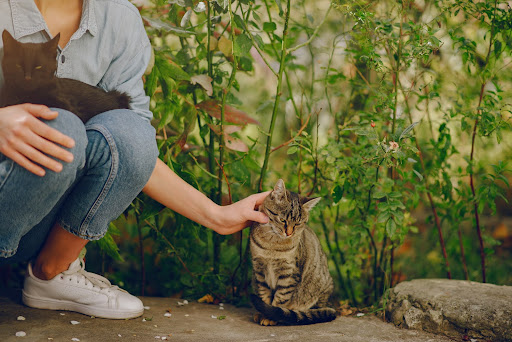
Regularly observe your cat’s behavior in the garden. Pay attention to their preferences, favorite spots, and any signs of discomfort or stress. Be open to rearranging elements in the garden. Cats may show a preference for certain areas or avoid others. Adjust accordingly.
Introduce new features or hiding spots gradually. Observe how your cat responds. If they enjoy it, great! If not, try something else.
Does your cat seem confident exploring every nook and cranny, or are they skittish and hesitant? Adjust hiding spots and climbing structures to cater to their personality. Redirect scratching instincts to designated scratching posts by placing them in areas your cat frequents.
Closure
With a little planning and these handy tips, you can transform your garden into a feline wonderland! From stimulating plants and climbing structures to cozy hideaways and refreshing water sources, you can create a safe and enriching outdoor paradise for your adventurous cat.
How will you enhance your cat-friendly garden today? Let us know in the comments and share this article with your friends and family.

